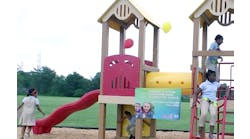The attention being given to the problem of childhood obesity has placed greater emphasis on students' eating more healthful diets and getting more exercise.
"Children need 60 minutes of play with moderate to vigorous activity every day to grow up to a healthy weight," says the federal government's "Let's Move" initiative to encourage students to exercise more often.
For schools, that means providing students not only with physical-education classes, but also with playgrounds where children on recess or before or after the school day can get a break from studies and get some physical activity in a non-structured setting.
The National Program for Playground Safety (NPPS), based at the University of Northern Iowa, has a four-step national action plan for playgrounds: provide proper playground supervision; design age-appropriate playgrounds; provide proper surfacing under and around equipment; and keep equipment properly maintained. The U.S. Consumer Product Safety Commission (CPSC) Public Safety Handbook covers similar recommendations.
Supervision
Adults should always be present when children are playing at a school playground. Administrators should make sure that playgrounds are adequately staffed during school recess periods. Some schools may rely on parent volunteers to help monitor playgrounds. The NPPS says that adults supervising a playground anticipate preventable problems and hazardous situations; stay alert and attentive; and remain present whenever children are on the playground.
Because all playgrounds present some challenge and because children can be expected to use equipment in unintended and unanticipated ways, adult supervision is highly recommended," the CPSC guide says.
Age Appropriate
Playground planners should select age-appropriate equipment and separate play areas for different age groups: 6 months through 23 months; ages 2 to 5; and 5 to 12. These areas should be marked by signage indicating the age-appropriate areas.
For children 6 months through 23 months, the playground should have areas where children can crawl, stand and walk.
For ages 2 to 5, the NPPS says, appropriate play areas could include: areas to crawl; low platforms with multiple access such as ramps and ladders; ramps with pieces attached for grasping; low tables for sand, water and manipulation of materials; tricycle paths with various textures; flexible spring rockers; sand areas with covers; and shorter slides (usually no taller than 4 feet). Some playground equipment that is not recommended for ages 2 to 5 are chain or cable walks; fulcrum seesaws; log rolls; track rides; swinging gates; free-standing arch climbers; free-standing climbing events with flexible components; overhead rings; parallel bars; long spiral slides with more than one 360-degree turn and vertical sliding poles.
For ages 5 to 12, some developmentally appropriate play areas for school-age children are rope or chain climbers on angles; climbing pieces; horizontal bars; cooperative pieces such as tire swings, slides and sliding poles; and open spaces to run and play ball.
The CPSC recommends that public parks should not offer trampolines, swinging gates, giant stride swings, climbing ropes that are not secured at both ends, heavy metal swings such as those shaped like animals, multiple-occupancy swings, rope swings and swinging dual exercise rings.
Breaking the fall
The NPPS says that about 70 percent of playground injuries are related to falls to the surface. To provide safe play areas, schools need to make sure that the proper surfaces are installed below play equipment.
"A playground should never be installed without protective surfacing of some type," the CPSC guide says. "Concrete, asphalt, or other hard surfaces should never be directly under playground equipment. Grass and dirt are not considered protective surfacing because wear and environmental factors can reduce their shock absorbing effectiveness.
Surfacing for playground falls into two categories: unitary and loose-fill. Unitary materials are generally rubber mats and tiles or a combination of energy-absorbing materials poured in place at the playground site to form a unitary shock absorbing surface.
Materials deemed safe for playground surfaces are pea gravel, sand, shredded/recycled rubber mulch, some types of wood mulch, wood chips or other material that meets ASTM standards.
The CPSC offers several tips for installing loose-fill surfacing at playgrounds:
-
Take into account that loose-fill materials will compress at least 25 percent over time from use and weathering.
-
Loose-fill surfacing requires frequent maintenance to ensure surfacing levels do not drop below the minimum depth. Areas under swings and at slide exits are more susceptible to displacement; mats can be installed in these areas to reduce displacement.
-
The perimeter of the playground should provide a method of containing the loose-fill materials.
-
Consider marking equipment supports with a minimum fill level to aid in maintaining the original depth of material.
-
Good drainage is essential to maintaining loose-fill surfacing. Standing water reduces effectiveness and leads to material compaction and decomposition.
-
Never use less than 9 inches of loose-fill material except for shredded/recycled rubber (6 inches recommended). Shallower depths are too easily displaced and compacted.
-
Some loose-fill materials may not meet accessibility guidelines.
-
Wood mulch containing products treated with chromated copper arsenate (CCA) should not be used.
Maintenance
Those in charge of playgrounds should make sure that workers are carrying out routine maintenance of playgrounds. The NPPS recommends that a maintenance program should monitor these conditions:
-
Equipment should be free of deterioration.
-
Wood equipment should be free of splinters.
-
Metal equipment should be free of rust.
-
Plastic equipment should be free of cracks.
-
S-hooks should be closed.
-
No openings from 3.5 inches to 9 inches to prevent children's heads or body parts from becoming trapped.
-
No open areas at the top of slides where strings could get caught and cause strangulation.
-
No more than two swings in a support structure.
-
The playground area should have proper drainage.
Sidebar: Finding the Time and Place
Striving to fit the entire required curriculum into what is one of the shortest instructional days in the nation, less than half of Chicago's public elementary schools have been offering recess to children.
That will change in 2012-13 if the city and the teachers union can reach agreement on Mayor Rahm Emanuel's proposal to lengthen the public school day to 7 hours from 5¾ hours becomes a reality. Part of the added time will be allocated for daily recess at all of the district's 474 elementary schools.
In acknowledgement of the renewed focus on recess and daily physical activity for students, the Chicago school system has put together a guide, "Developing a School Recess Plan."
"If a school has playground equipment available, the School Reces
s Plan should consider whether that equipment is suitable for all grade levels," the guide says.
A 2011 survey of principals found that 79 percent reported having playground equipment appropriate for grades K to 3; 32 percent had equipment appropriate for grades 4 to 6; only 13 percent had equipment appropriate for grades 7 to 8.
"If playground equipment is suitable only for the youngest students, then older students should engage in unstructured play activities," the guide says.
The district's budget problems make it unlikely that money would be available to provide equipment for older elementary students, so the guide suggests that individual schools use some of their discretionary funds or conduct fund raising to pay for additional playground equipment. Other considerations that recess plans should address: whether a school has a usable exterior space to accommodate recess and whether "neighborhood conditions … could adversely affect the school's ability to safely implement outdoor recess." If outdoor recess is not feasible, the school should have a plan for indoor recess. The guide notes that this may "present a significant challenge in schools without available and suitable interior space." Planning for interior recess activities must be made in advance, the district says.
Kennedy, staff writer, can be reached at [email protected].
Related Video
Watch a video about the "Let's Move" campaign:


